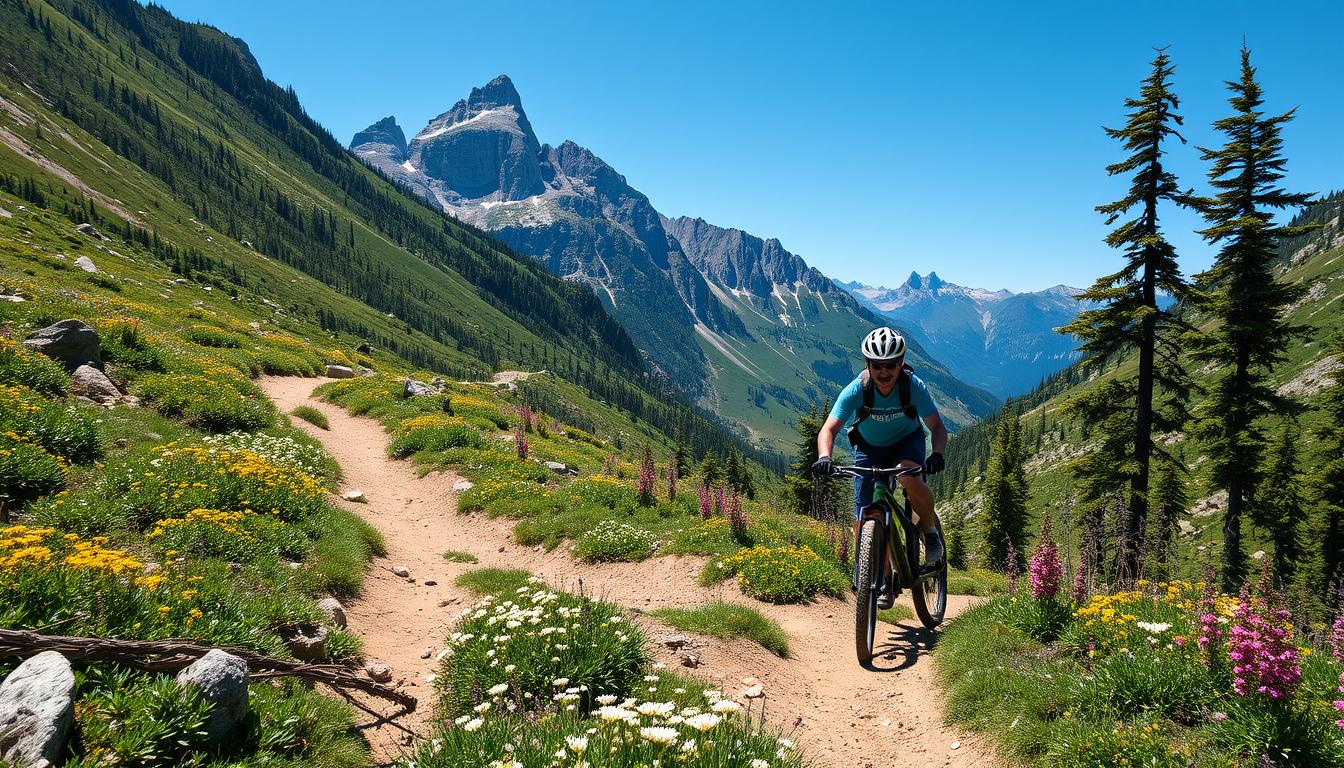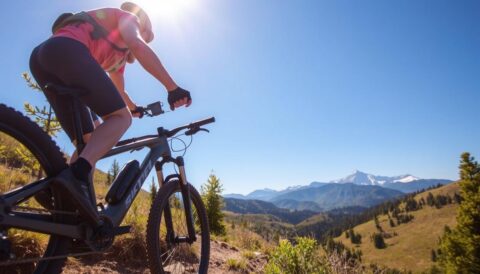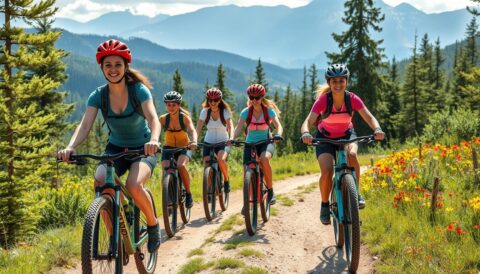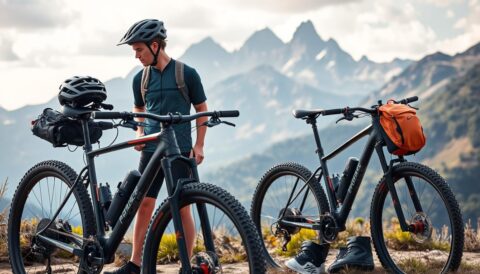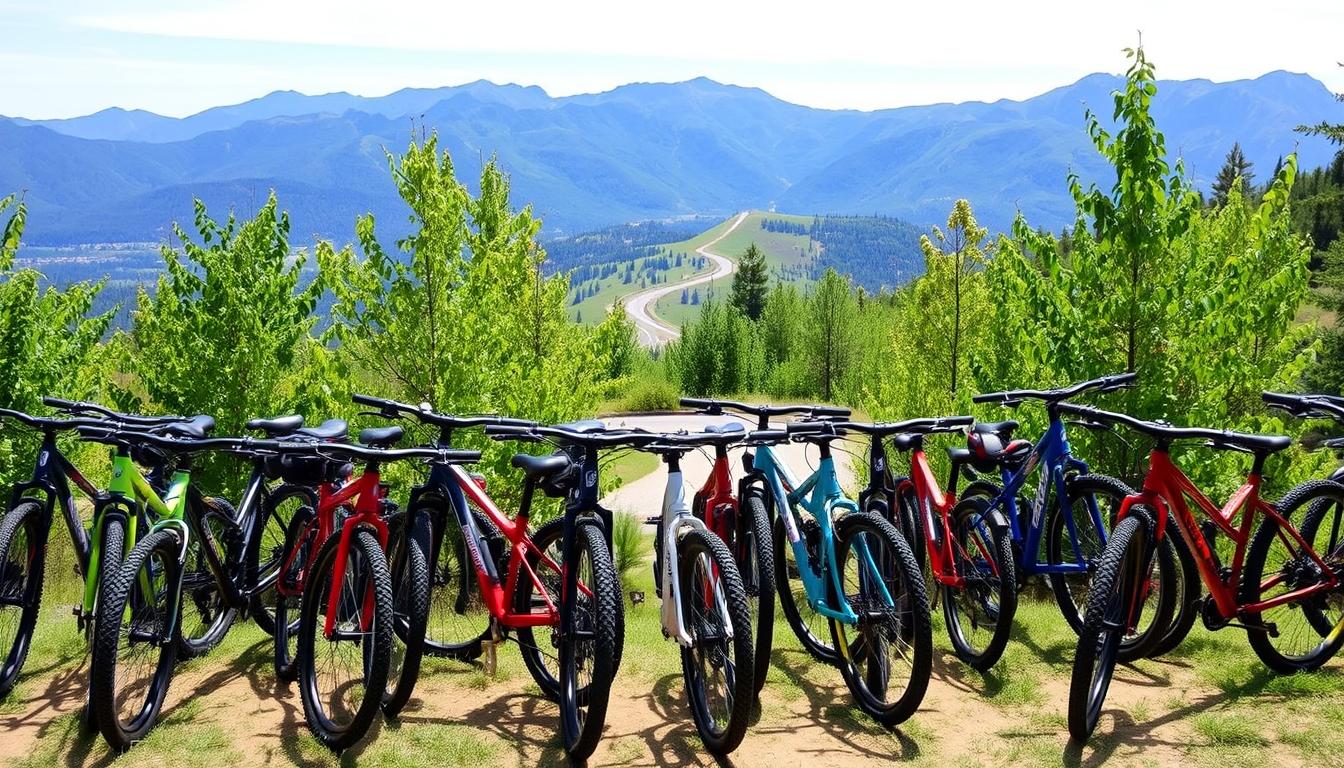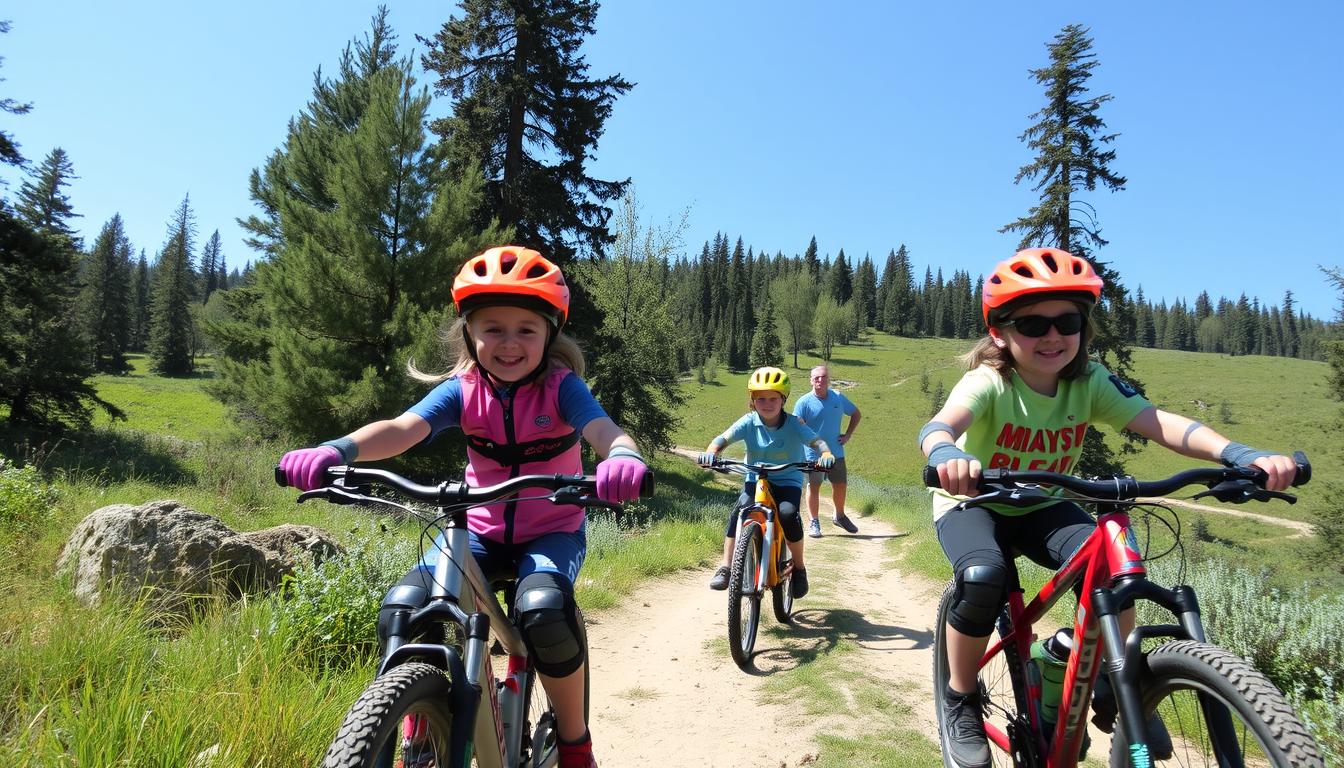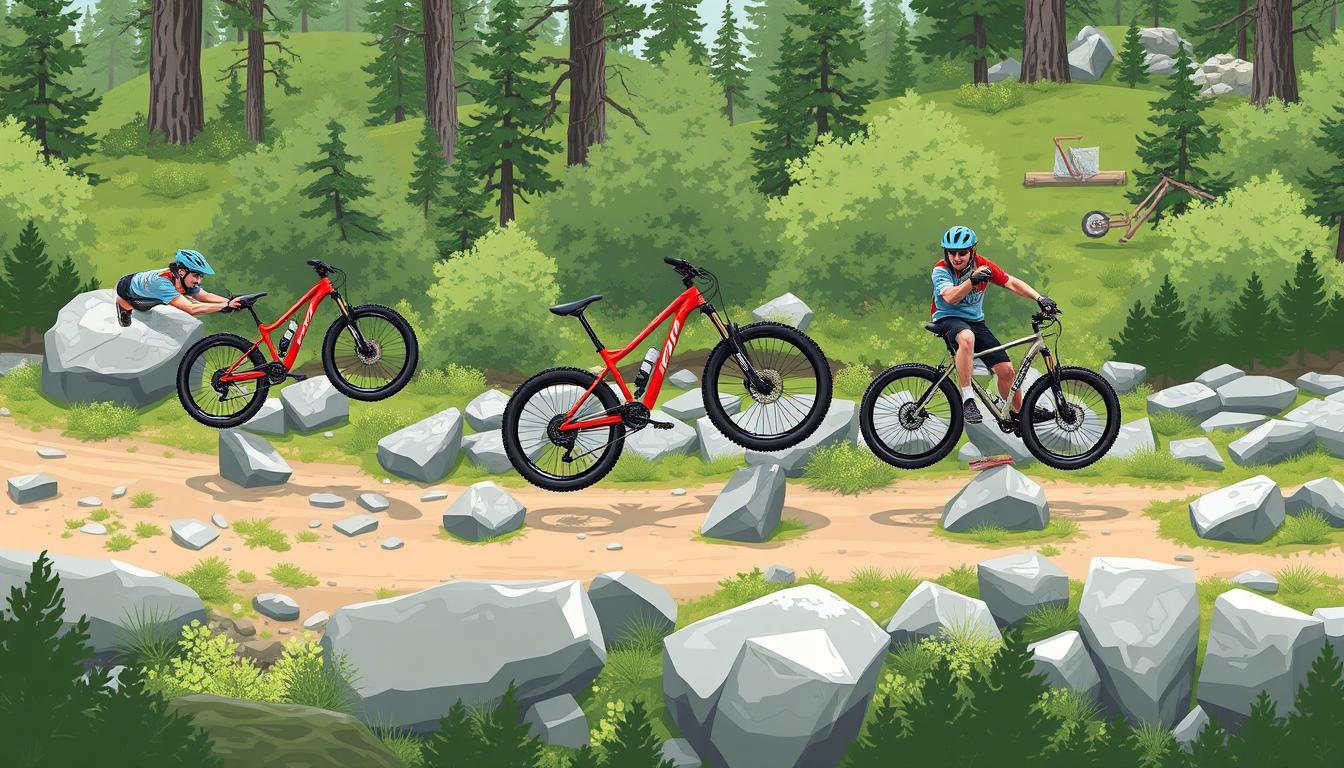Mountain biking blends outdoor adventure with full-body exercise. It challenges both body and mind, offering a dynamic workout1. This sport helps improve strength, endurance, and heart health whilst exploring beautiful landscapes.
Cycling fitness isn’t just about pedalling. It’s about developing a complete physical approach. Mountain bike exercise includes varied workout intensities and high-intensity intervals2.
Riders build power through low-cadence, high-force movements. These differ greatly from traditional road cycling techniques1.
Mountain biking’s versatility is its strong point. Each ride offers a chance to boost your fitness. It can take twice as long as road cycling, giving an extended workout3.
New riders should build a solid fitness base. Long, low-intensity training is great for lasting improvements1. Gradually increase your skills and stamina to become a confident trail explorer.
The main aim is to have fun. Mountain biking isn’t just about getting fit. It’s about enjoying outdoor thrills and personal growth. Your first rides may be tough3.
But every pedal stroke brings you closer to mastering this exciting sport. Keep at it, and you’ll soon reap the rewards.
Getting Started with Mountain Biking: Essential Equipment and Safety
Mountain biking thrills riders but requires careful prep and proper gear. Beginners must grasp key aspects of selecting equipment and ensuring safety before tackling trails.
Choosing a mountain bike isn’t just about style. Your bike should match your skills and body type. Safety gear is crucial for protecting you during rides.
Choosing the Right Bike for Your Skill Level
For novices, bike selection is key. Consider these factors when picking your first mountain bike:
- Frame size appropriate to your height
- Comfortable geometry for trail riding
- Suspension suitable for your terrain
- Budget-friendly options for entry-level riders
Essential Safety Gear and Accessories
Quality cycling safety gear is a must-have. A well-fitted helmet is absolutely critical4.
Entry-level mountain biking helmets cost between £50 and £150. These offer protection for various budgets4.
| Safety Item | Protection Level | Recommended Use |
|---|---|---|
| Helmet | 70% injury prevention | Always wear while riding |
| Gloves | Enhanced grip | Rough terrain control |
| Knee Pads | 50% injury reduction | Technical trail riding |
Proper Bike Fit and Comfort Considerations
Bike fitting for beginners involves understanding how your body interacts with the bicycle. Ideal foot positioning on pedals ensures maximum efficiency5.
Stiff-soled mountain biking shoes can boost pedalling power by up to 15%4. Seat height, handlebar position, and overall comfort are also important.
“The right equipment transforms a challenging ride into an enjoyable experience.”
A basic repair kit can fix 80% of potential mechanical issues on trails4. This kit is essential for a smooth riding experience.
Beginner Mountain Biking for Fitness: Building Your Foundation
Mountain biking offers a brilliant full-body workout for beginners. It’s essential to build strength and endurance safely. This thrilling sport enhances overall fitness levels effectively.
“Start slow and progress gradually to prevent burnout and build confidence”
For your beginner trail riding adventure, focus on these key fitness components:
- Strength Training: Incorporate exercises twice weekly6
- Aerobic Training: Aim for at least one ride per week6
- Recovery: Prioritise 8-9 hours of sleep nightly6
To boost performance, ride in Zone 2 heart rate. This approach develops aerobic fitness effectively. Single-leg exercises like lunges can enhance mountain biking leg strength.
| Training Component | Recommended Frequency | Key Benefits |
|---|---|---|
| Strength Training | 2x per week | Muscle development, injury prevention |
| Aerobic Rides | 1x per week | Endurance improvement |
| Protein Intake | 1.5-2g per kg body weight | Muscle recovery and growth |
Consistency is crucial for improving your mountain biking performance. Small, regular changes over time can yield significant results. Ride with experienced cyclists to stay motivated and learn advanced techniques.
Mastering Basic Mountain Biking Skills and Techniques
Mountain biking blends technical skills with physical prowess. Beginners must grasp fundamental techniques to build confidence and safety on trails8.
World champion Brian Lopes stresses the importance of core cycling skills. Let’s explore essential techniques to enhance your mountain biking experience.
Braking and Speed Control Fundamentals
Effective braking is crucial in mountain biking. Riders should use front and rear brakes strategically.
- Apply approximately 70% of stopping power through the front brake
- Avoid sudden, aggressive braking that can cause skidding
- Modulate brake pressure to maintain control on varying terrains
Gear Shifting Strategies for Different Terrains
Gear shifting is vital for off-road biking. Different terrains require specific gear approaches.
| Terrain Type | Recommended Gear Strategy |
|---|---|
| Uphill Climb | Lower gears for increased pedalling efficiency |
| Flat Terrain | Mid-range gears for consistent speed |
| Downhill | Higher gears with controlled braking |
Body Positioning and Balance Tips
Proper body positioning can transform your cycling skills. Keep these techniques in mind:
- Maintain a relaxed stance with slightly bent arms and legs
- Shift your weight according to the terrain
- Look ahead to anticipate trail challenges
“Mastering mountain bike skills takes practice, patience, and persistence” – Lee McCormack, mountain biking expert8.
Focusing on these fundamental techniques lays a solid foundation. Beginners can develop an exciting and safe off-road cycling experience9.
Building Strength and Endurance for Trail Riding
Mountain biking fitness requires more than just riding your bike. It needs a mix of strength training and targeted exercises. These enhance your overall performance10.
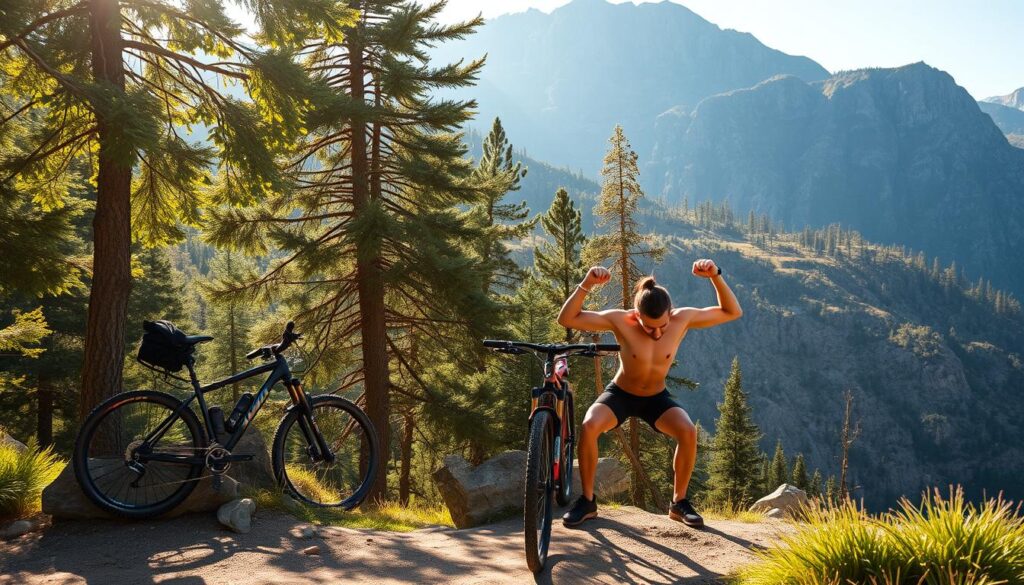
Top mountain bikers need a diverse fitness plan. This includes strength training, cardiovascular endurance, and technical skill development.
- Strength training for specific muscle groups
- Cardiovascular endurance
- Technical skill development
Strength training is vital for mountain biking success. Targeted exercises can greatly boost your riding skills11. Pro riders like Nino Schurter stress the importance of off-bike workouts.
Strength is not just about muscle—it’s about creating a more efficient, resilient rider.
A solid training plan should focus on key areas. These include leg strength, core stability, and upper body fitness.
| Focus Area | Exercise Examples | Frequency |
|---|---|---|
| Leg Strength | Squats, Lunges | 2-3 times weekly |
| Core Stability | Planks, Renegade Rows | 2 times weekly |
| Upper Body | Pull-ups, Push-ups | 2 times weekly |
High-intensity interval training can greatly improve your mountain biking skills12. Do 2-3 full-body strength sessions weekly. Adjust intensity based on your riding schedule and goals.
Consistency is crucial for mountain biking fitness. Use progressive overload and proper recovery. This balanced approach will make you a stronger, more skilled trail rider.
Nutrition and Recovery Strategies for Mountain Bikers
Cycling nutrition is vital for mountain biking performance and fitness. Proper fuelling and recovery can boost your riding experience. It can also unlock your athletic potential13.
Nutrition is key for mountain bikers tackling tough terrains. It directly impacts performance in cross-country mountain biking. A strategic approach to fuelling is crucial for endurance13.
Pre and Post-Ride Fuelling Strategies
Smart nutrition planning is essential for mountain biking recovery. Cyclists should eat a balanced diet rich in key nutrients.
- Complex carbohydrates
- Lean proteins
- Healthy fats
- Fresh fruits and vegetables
Protein is crucial for muscle repair and growth. Mountain bikers should aim for 20-25% of daily calories from protein.
This equals about 110-138 grams for a 2,200-calorie diet13.
Hydration Guidelines for Bikers
Proper hydration is crucial for peak performance in biking. During intense rides, athletes can burn up to 3200 kcal. This makes fluid replacement essential14.
| Protein Source | Protein Content |
|---|---|
| Chicken Breast (4 oz) | 31 grams |
| Salmon (4 oz) | 28 grams |
| Lentils (1 cup) | 17.9 grams |
Recovery Best Practices
Mountain biking recovery isn’t just about nutrition. Rest, proper sleep, and active recovery techniques are also key13.
Optimal recovery is about balancing nutrition, rest, and targeted muscle care.
Endurance athletes can now consume up to 120g of carbs per hour during exercise. This can significantly improve performance potential14.
Using these strategies can enhance fitness and prevent injuries. It can also lead to more effective training sessions for mountain bikers.
Conclusion
Mountain biking is more than exercise; it’s a life-changing experience. It offers a full-body workout, potentially boosting muscle strength by 10-15% for regular riders15. This activity enhances both physical fitness and mental well-being15.
The psychological perks of mountain biking are remarkable. Riders often see mood improvements of about 30%. Stress levels can drop by up to 60% with consistent outdoor cycling15.
Trail riding sharpens coordination, possibly improving reaction times by 15-30%15. After a ride, cyclists may feel 25-30% more energised, making it a truly rewarding pursuit16.
Your mountain biking journey is a personal growth experience. Each ride offers a chance to test yourself and bond with nature. Remember, steady practice leads to natural improvements in technique and fitness.
Mountain biking goes beyond typical exercise. It builds physical strength, mental toughness, and personal development. So, grab your gear and enjoy every moment of your thrilling mountain biking adventure!
FAQ
What equipment do I need to start mountain biking as a beginner?
You’ll need a suitable mountain bike, a well-fitted helmet, and cycling gloves. Padded bike shorts and proper cycling shoes are also essential. Quality safety gear and a correctly fitted bike ensure comfort and control.
How difficult are mountain bike trails for beginners?
Mountain bike trails vary in difficulty. Beginners should look for green-rated trails. These are relatively flat, wide, and have minimal technical features. Green trails help new riders build confidence and basic skills.
How often should I train to improve my mountain biking fitness?
Aim for 3-4 rides per week, starting with shorter, less intense sessions. Gradually increase duration and difficulty as you progress. Include strength training and rest days to prevent burnout and aid recovery.
What type of nutrition is best for mountain biking?
Eat complex carbohydrates before rides for energy. After rides, consume a mix of protein and carbohydrates to aid recovery. Stay hydrated by drinking water before, during, and after cycling.
How can I improve my mountain biking skills quickly?
Practise fundamental techniques like braking, gear shifting, and body positioning. Take skills workshops and ride with experienced cyclists. Challenge yourself on progressively difficult trails to enhance your abilities.
Is mountain biking a good workout?
Yes! Mountain biking provides a full-body workout that improves cardiovascular fitness. It builds leg and core strength while offering low-impact exercise. Plus, you get to enjoy nature while working out.
What safety precautions should I take as a beginner?
Always wear a helmet and start on beginner-friendly trails. Learn proper bike handling techniques and carry a basic repair kit. Bring plenty of water and ride within your skill level. Consider riding with experienced cyclists when starting out.
How expensive is it to start mountain biking?
You can start mountain biking with a moderate budget. Entry-level mountain bikes cost between £300-£700. Essential gear like a helmet and basic accessories run about £100-£200. Consider second-hand options to reduce initial costs.
What type of bike should a beginner choose?
Beginners should opt for a hardtail mountain bike with front suspension. These bikes offer good value, versatility, and easier maintenance. Choose a bike that fits your body size and suits your riding style.
How can I prevent injury while mountain biking?
Maintain proper bike fit and wear protective gear to prevent injuries. Gradually increase ride intensity and perform strength and flexibility training. Learn correct riding techniques from experienced cyclists or professional instructors.
Source Links
- 21 Effective MTB Training Tips — High North Performance
- MTB (Mountain Biking) / off-road workouts?
- Mountain Bike Training for Beginners – Cycling Training Tips
- Mountain Biking Essentials: Your Ultimate Starter Kit Guide
- Mountain Biking 101 | Campus Recreation
- Mountain Bike Fitness for Beginners: Your Essential Guide
- MTB Beginner Exercises – Women’s MTB Network
- Mastering Mountain Bike Skills 3rd Edition
- Mastering Mountain Bike Skills – 3rd Edition by Brian Lopes & Lee McCormack (Paperback)
- Mountain Bike Training Program | JOIN
- Strength training for mountain biking – 5 exercises that will make you faster on the trails
- MTB Fitness For Trail Riders
- Mountain Biking Nutrition: Powerful Nutrition Principles for Fueling Your Ride and Health – Alpine Fuel Nutrition
- Mountain bike nutrition – the art of training the gut and everything in between
- Here’s Why Mountain Biking is the Perfect Fall Fitness Routine – Howler Bike Park
- 7 Reasons Why Mountain Biking is the Best Form of Exercise
